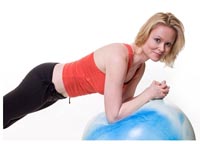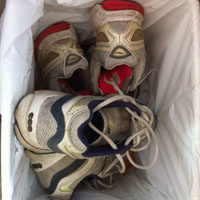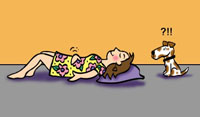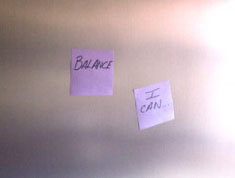 Somewhere along the way, ‘abdominals’ became synonymous with ‘core’. (When and why, we’ll never know.) To millions of people, strengthening your ‘core’ now means strengthening only your abs, which is not all together true. Your core is actually the corset of muscles that help to stabilize your spine, and include not only the abdominals but the latissimus dorsi, trapezius, rhomboids and erector spinae muscles, hip flexors, and glutes. All these work together to keep your spine upright and erect, so it’s important to engage all of them when strengthening your ‘core’.
Somewhere along the way, ‘abdominals’ became synonymous with ‘core’. (When and why, we’ll never know.) To millions of people, strengthening your ‘core’ now means strengthening only your abs, which is not all together true. Your core is actually the corset of muscles that help to stabilize your spine, and include not only the abdominals but the latissimus dorsi, trapezius, rhomboids and erector spinae muscles, hip flexors, and glutes. All these work together to keep your spine upright and erect, so it’s important to engage all of them when strengthening your ‘core’.
People have gotten so consumed with washboard abs that back muscles have actually taken a back seat to the abdominals. Granted, washboard abs do look great out on the beach, but what you don’t see is that a lot of those people could easily be suffering from serious back pain and have no clue as to why. What good is a six-pack if you’re walking around like the Hunchback of Notre Dame? Working out your back muscles is so important because those muscles help to keep your spine properly aligned, and when they’re strong they protect against injury, help reduce back pain, improve your posture and can make your back look sleek and sexy. (Sorry ladies but you’re going to have to do lots of cardio to get rid of that back fat. Spot reducing just doesn’t exist. And remember that when you’re banging out 100 crunches; fat will still reside on your belly no matter how many you perform.)
Which brings me to the crunch, the one exercise that I rarely allow a client to perform. Why you may ask? Because I have seen so many women bang out 50 crunches and afterwards tell me that they could do that all day long because they didn’t feel a thing. Um, wait a minute… strength training is about working your muscles to the point of fatiguing them. If you don’t feel anything, then something just ain’t right.
What I offer clients instead of crunches are exercises that brace the ab muscles (and back muscles) without putting undo stress on the spine. (Bracing your muscles means holding in your stomach as if someone was about to punch you.) For example, planks are one of the best exercises for your core. Here, all the muscles of your core contract to stabilize the spine, keeping it in neutral position, meaning there is a slight inward curve at the small of your back, and you hold this position on your toes and hands or forearms for however long you can. There is also the side plank which involves the same motions, except you’re using only one arm to support you and you’re on your side. The point here is to work all the muscles of your core without focusing on just one, like the rectus abdominis or the inner obliques. Engage all your muscles, stabilize your spine and then if you want to add a rotation to really work the obliques, go for it. But don’t just lie on your back, hands behind your head, back pressed into the floor and pull your head and neck up (inevitably with your hands) and jerk your elbow up and out to the opposite side. I’ve heard about so many people getting injuries that way. Will you just quit it already?
Here are some great exercises you can do to replace your old, stale crunches and really get your core strengthened:
Bridges
Lie on your back with your knees bent. Keep your back in a neutral position, not arched and not pressed into the floor. Avoid tilting your hips. Tighten your abdominal muscles. Raise your hips off the floor until your hips are aligned in-between your knees and shoulders in a straight, downward line (knees up high, hips in the middle, shoulders on the floor). Hold for three deep breaths. Return to the start position and repeat.
Single-leg Abdominal Press
Lie on your back with your knees bent. Keep your back in a neutral position, not arched and not pressed into the floor. Avoid tilting your hips. Tighten your abdominal muscles. Raise your right leg off the floor so that your knee is at 90-degrees (shin is parallel to the floor). Place your right hand on top of your right knee. Push your hand against your knee while using your abdominal muscles to pull your knee toward your hand. Keep your arm straight. Hold for three deep breaths. Release and then repeat using your left hand and left knee.
Bird Dog
Start on your hands and knees. Place your hands directly below your shoulders, knees below your hips and align your head and neck with your back (like a table). Tighten your abdominal muscles while keeping your spine neutral (keeping that small curve in your lower back). Raise your right arm off the floor and reach ahead while raising your left leg up and straightening it behind you. Hold for three deep breaths. Lower your right arm and left leg and repeat with your left arm and right leg.






